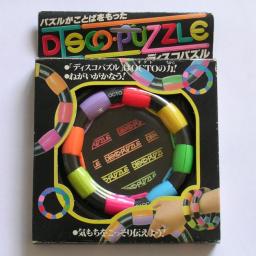


The Octo puzzle, also known as the Disco Puzzle or Meeting Colors, consists of a ring about the size of an armband, with 8 differently coloured cylindrical sections. Each section has 4 identical pieces, and can rotate. The ring itself is sliced in half like a bagel into two layers, and these can rotate too, thus mixing together the sections.
This puzzle is closely related to the Combo Puzzle, though that puzzle has 6 sections of 6 distinct pieces instead of 8 sections of 4 identical ones. Octo was released in the UK in a packaging showing the magician Paul Daniels.
If your browser supports JavaScript, then you can play the Octo by clicking the link below:
There are 32 pieces, which gives a maximum of 32! positions. This limit is not reached because:
This last factor comes about because it does not matter which colour goes in which section. This leaves 32!/4!8 /8! = 59,287,247,761,257,140,625 or 5.9·1019 positions. There are 16 orientations of the puzzle as a whole, so this number should be divided by 16 to get the approximate number of really distinct positions, namely 3.7·1018. For the exact number, you need to apply Burnside's Lemma, but that is rather complicated in this case.